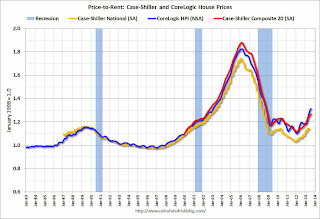by Calculated Risk on 10/29/2013 11:56:00 AM
Tuesday, October 29, 2013
Comment on House Prices: Real Prices, Price-to-Rent Ratio, Cities
It appears house price increases have slowed recently based on agent reports and asking prices (a combination of a little more inventory and higher mortgage rates), but this slowdown in price increases is not showing up yet in the Case-Shiller index because of the reporting lag and because of the three month average (the August report was an average of June, July and August prices). I expect to see smaller year-over-year price increases going forward and some significant deceleration towards the end of the year or in early 2014.
I also think it is important to look at prices in real terms (inflation adjusted). Case-Shiller, CoreLogic and others report nominal house prices. As an example, if a house price was $200,000 in January 2000, the price would be close to $276,000 today adjusted for inflation. That is why the second graph below is important - this shows "real" prices (adjusted for inflation).
Zillow's chief economist Stan Humphries said today: "Home value appreciation is better when it’s boring", and I agree. I'd sure like to see nominal price increases closer to the level of inflation. But that is just wishcasting (as opposed to forecasting).
Earlier: Case-Shiller: Case-Shiller: Comp 20 House Prices increased 12.8% year-over-year in August
Nominal House Prices
 The first graph shows the quarterly Case-Shiller National Index SA (through Q2 2013), and the monthly Case-Shiller Composite 20 SA and CoreLogic House Price Indexes (through August) in nominal terms as reported.
The first graph shows the quarterly Case-Shiller National Index SA (through Q2 2013), and the monthly Case-Shiller Composite 20 SA and CoreLogic House Price Indexes (through August) in nominal terms as reported.
In nominal terms, the Case-Shiller National index (SA) is back to Q4 2003 levels (and also back up to Q4 2008), and the Case-Shiller Composite 20 Index (SA) is back to April 2004 levels, and the CoreLogic index (NSA) is back to October 2004.
Real House Prices
 The second graph shows the same three indexes in real terms (adjusted for inflation using CPI less Shelter). Note: some people use other inflation measures to adjust for real prices.
The second graph shows the same three indexes in real terms (adjusted for inflation using CPI less Shelter). Note: some people use other inflation measures to adjust for real prices.
In real terms, the National index is back to Q4 2000 levels, the Composite 20 index is back to December 2001, and the CoreLogic index back to June 2002.
In real terms, house prices are back to early '00s levels.
Price-to-Rent
In October 2004, Fed economist John Krainer and researcher Chishen Wei wrote a Fed letter on price to rent ratios: House Prices and Fundamental Value. Kainer and Wei presented a price-to-rent ratio using the OFHEO house price index and the Owners' Equivalent Rent (OER) from the BLS.
 Here is a similar graph using the Case-Shiller National, Composite 20 and CoreLogic House Price Indexes.
Here is a similar graph using the Case-Shiller National, Composite 20 and CoreLogic House Price Indexes.
This graph shows the price to rent ratio (January 1998 = 1.0).
On a price-to-rent basis, the Case-Shiller National index is back to Q4 2000 levels, the Composite 20 index is back to May 2002 levels, and the CoreLogic index is back to February 2003.
In real terms - and as a price-to-rent ratio - prices are mostly back to early 2000 levels.
Nominal Prices: Cities relative to Jan 2000
 The last graph shows the bubble peak, the post bubble minimum, and current nominal prices relative to January 2000 prices for all the Case-Shiller cities in nominal terms.
The last graph shows the bubble peak, the post bubble minimum, and current nominal prices relative to January 2000 prices for all the Case-Shiller cities in nominal terms.
As an example, at the peak, prices in Phoenix were 127% above the January 2000 level. Then prices in Phoenix fell slightly below the January 2000 level, and are now up 39% above January 2000.
These are nominal prices, and as I noted above real prices (adjusted for inflation) are up about 38% since January 2000 - so the increase in Phoenix from January 2000 until now is about the change in inflation.
Two cities - Denver (up 43% since Jan 2000) and Dallas (up 28% since Jan 2000) - are at new highs (no other Case-Shiller Comp 20 city is very close). Denver is up slightly more than inflation over that period, and Dallas slightly less. Detroit prices are still below the January 2000 level.


